Evaluating Operations Management and Leadership at Toyota
VerifiedAdded on 2022/01/15
|19
|5095
|121
Report
AI Summary
This report provides an analysis of operations management and leadership within Toyota, focusing on key theories and approaches such as Six Sigma, Lean Production, and Queuing Theory. It examines different operations management approaches including Management by Objectives (MBO), SMART criteria, Total Quality Management (TQM), Kaizen, and Just-in-Time (JIT) production, highlighting Toyota's application of JIT. The report proposes a SMART objective for Toyota and evaluates the importance of operations management in achieving business objectives. It also discusses the key operational functions of the business and how managing these functions helps Toyota achieve its objectives. Furthermore, the report assesses the impact of COVID-19 and contemporary management issues on Toyota's operational management and decision-making, considering stakeholder pressures and suggesting responses by leaders and managers. The analysis concludes by summarizing key findings and offering a self-criticism of the work.
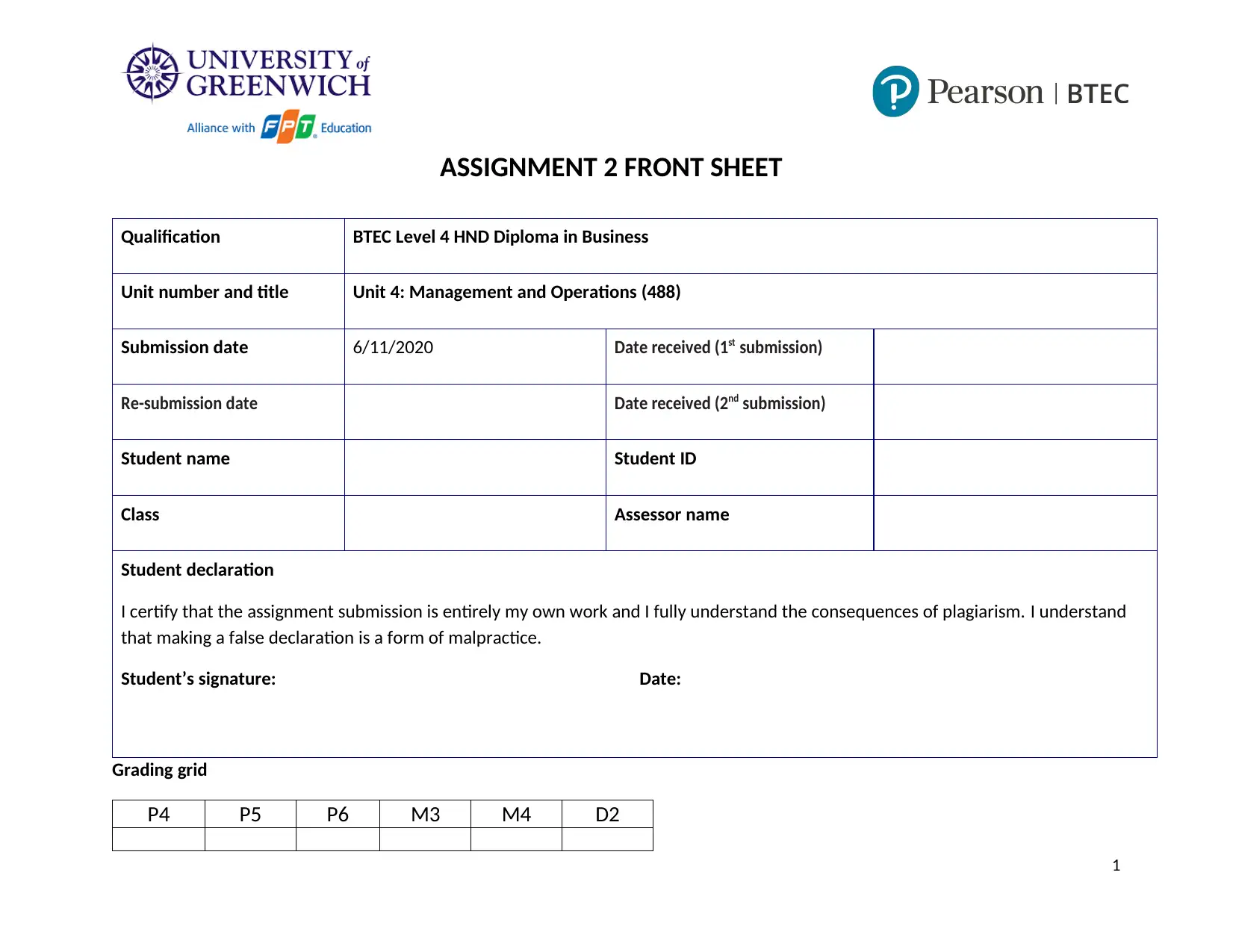
ASSIGNMENT 2 FRONT SHEET
Qualification BTEC Level 4 HND Diploma in Business
Unit number and title Unit 4: Management and Operations (488)
Submission date 6/11/2020 Date received (1 st submission)
Re-submission date Date received (2 nd submission)
Student name Student ID
Class Assessor name
Student declaration
I certify that the assignment submission is entirely my own work and I fully understand the consequences of plagiarism. I understand
that making a false declaration is a form of malpractice.
Student’s signature: Date:
Grading grid
P4 P5 P6 M3 M4 D2
1
Qualification BTEC Level 4 HND Diploma in Business
Unit number and title Unit 4: Management and Operations (488)
Submission date 6/11/2020 Date received (1 st submission)
Re-submission date Date received (2 nd submission)
Student name Student ID
Class Assessor name
Student declaration
I certify that the assignment submission is entirely my own work and I fully understand the consequences of plagiarism. I understand
that making a false declaration is a form of malpractice.
Student’s signature: Date:
Grading grid
P4 P5 P6 M3 M4 D2
1
Paraphrase This Document
Need a fresh take? Get an instant paraphrase of this document with our AI Paraphraser
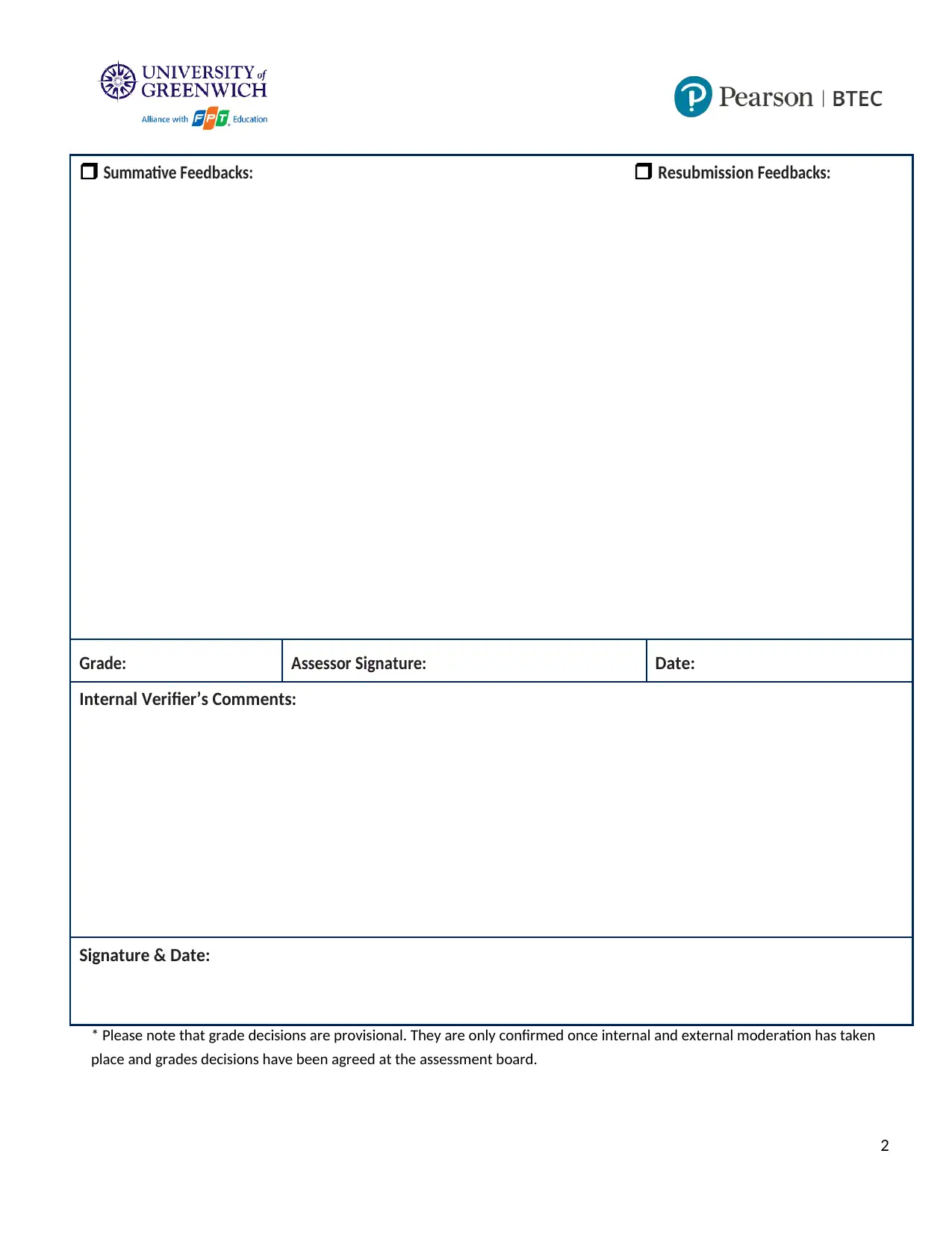
Summative Feedbacks: Resubmission Feedbacks:
Grade: Assessor Signature: Date:
Internal Verifier’s Comments:
Signature & Date:
* Please note that grade decisions are provisional. They are only confirmed once internal and external moderation has taken
place and grades decisions have been agreed at the assessment board.
2
Grade: Assessor Signature: Date:
Internal Verifier’s Comments:
Signature & Date:
* Please note that grade decisions are provisional. They are only confirmed once internal and external moderation has taken
place and grades decisions have been agreed at the assessment board.
2
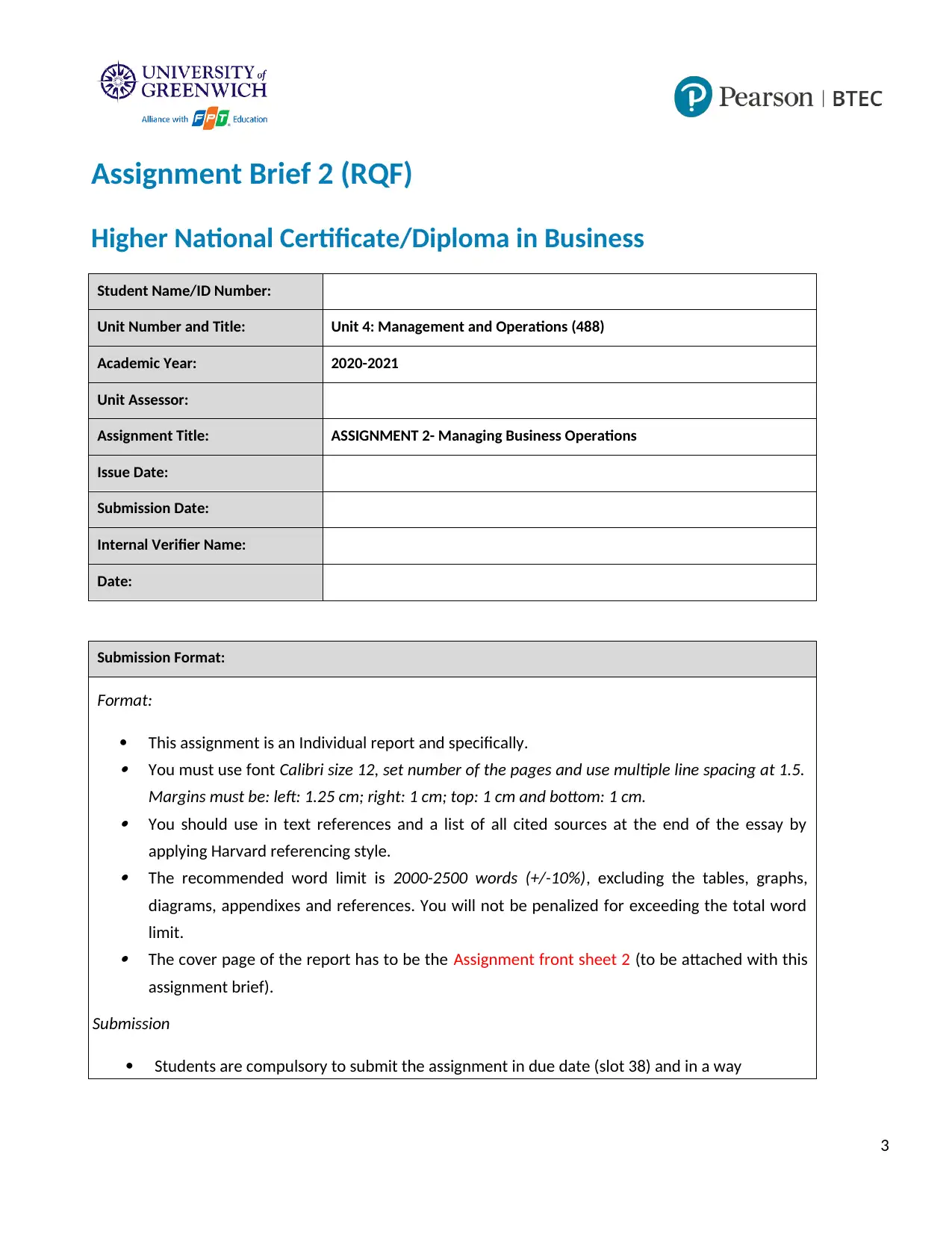
Assignment Brief 2 (RQF)
Higher National Certificate/Diploma in Business
Student Name/ID Number:
Unit Number and Title: Unit 4: Management and Operations (488)
Academic Year: 2020-2021
Unit Assessor:
Assignment Title: ASSIGNMENT 2- Managing Business Operations
Issue Date:
Submission Date:
Internal Verifier Name:
Date:
Submission Format:
Format:
This assignment is an Individual report and specifically. You must use font Calibri size 12, set number of the pages and use multiple line spacing at 1.5.
Margins must be: left: 1.25 cm; right: 1 cm; top: 1 cm and bottom: 1 cm. You should use in text references and a list of all cited sources at the end of the essay by
applying Harvard referencing style. The recommended word limit is 2000-2500 words (+/-10%), excluding the tables, graphs,
diagrams, appendixes and references. You will not be penalized for exceeding the total word
limit. The cover page of the report has to be the Assignment front sheet 2 (to be attached with this
assignment brief).
Submission
Students are compulsory to submit the assignment in due date (slot 38) and in a way
3
Higher National Certificate/Diploma in Business
Student Name/ID Number:
Unit Number and Title: Unit 4: Management and Operations (488)
Academic Year: 2020-2021
Unit Assessor:
Assignment Title: ASSIGNMENT 2- Managing Business Operations
Issue Date:
Submission Date:
Internal Verifier Name:
Date:
Submission Format:
Format:
This assignment is an Individual report and specifically. You must use font Calibri size 12, set number of the pages and use multiple line spacing at 1.5.
Margins must be: left: 1.25 cm; right: 1 cm; top: 1 cm and bottom: 1 cm. You should use in text references and a list of all cited sources at the end of the essay by
applying Harvard referencing style. The recommended word limit is 2000-2500 words (+/-10%), excluding the tables, graphs,
diagrams, appendixes and references. You will not be penalized for exceeding the total word
limit. The cover page of the report has to be the Assignment front sheet 2 (to be attached with this
assignment brief).
Submission
Students are compulsory to submit the assignment in due date (slot 38) and in a way
3
⊘ This is a preview!⊘
Do you want full access?
Subscribe today to unlock all pages.

Trusted by 1+ million students worldwide
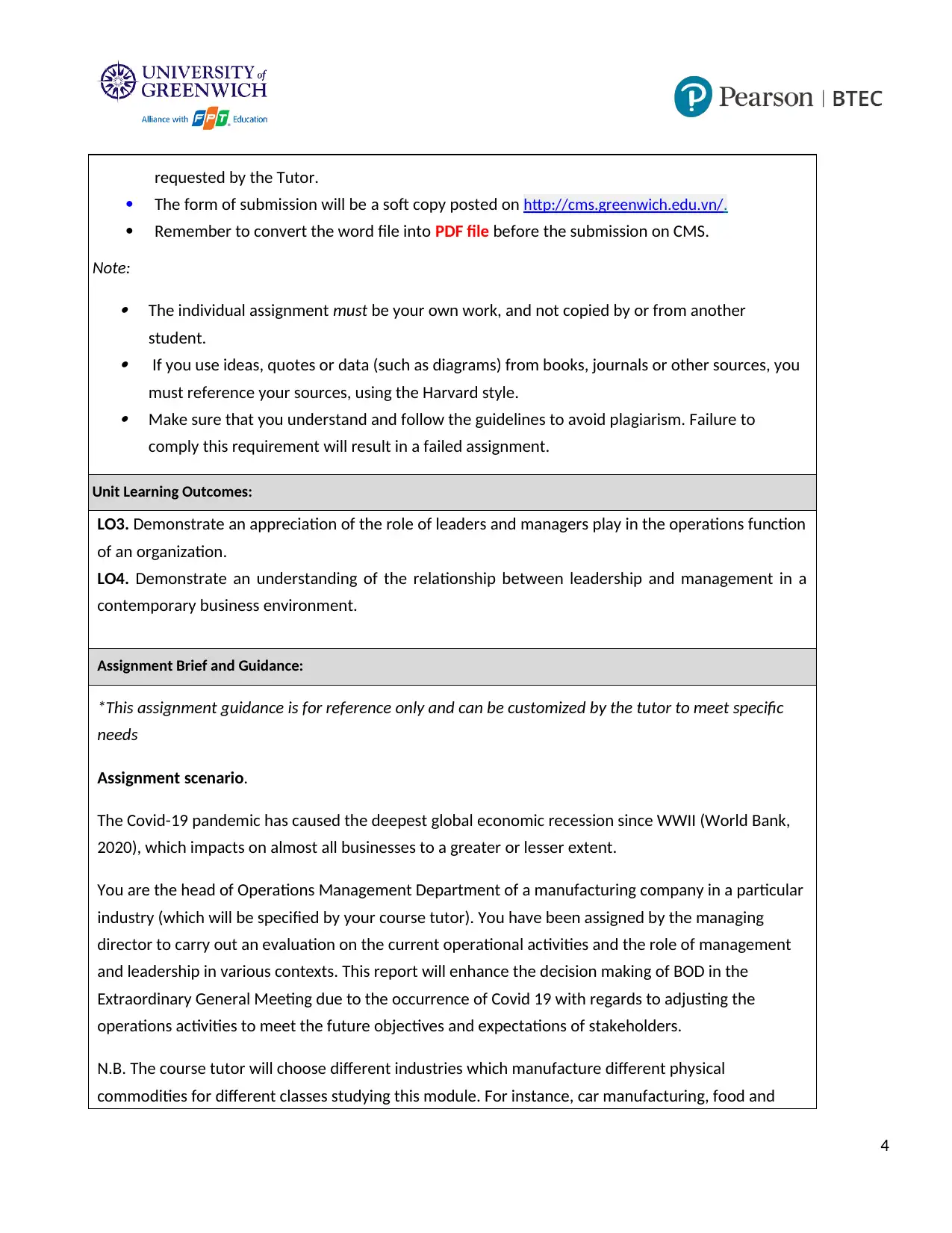
requested by the Tutor.
The form of submission will be a soft copy posted on http://cms.greenwich.edu.vn/.
Remember to convert the word file into PDF file before the submission on CMS.
Note:
The individual assignment must be your own work, and not copied by or from another
student. If you use ideas, quotes or data (such as diagrams) from books, journals or other sources, you
must reference your sources, using the Harvard style. Make sure that you understand and follow the guidelines to avoid plagiarism. Failure to
comply this requirement will result in a failed assignment.
Unit Learning Outcomes:
LO3. Demonstrate an appreciation of the role of leaders and managers play in the operations function
of an organization.
LO4. Demonstrate an understanding of the relationship between leadership and management in a
contemporary business environment.
Assignment Brief and Guidance:
*This assignment guidance is for reference only and can be customized by the tutor to meet specific
needs
Assignment scenario.
The Covid-19 pandemic has caused the deepest global economic recession since WWII (World Bank,
2020), which impacts on almost all businesses to a greater or lesser extent.
You are the head of Operations Management Department of a manufacturing company in a particular
industry (which will be specified by your course tutor). You have been assigned by the managing
director to carry out an evaluation on the current operational activities and the role of management
and leadership in various contexts. This report will enhance the decision making of BOD in the
Extraordinary General Meeting due to the occurrence of Covid 19 with regards to adjusting the
operations activities to meet the future objectives and expectations of stakeholders.
N.B. The course tutor will choose different industries which manufacture different physical
commodities for different classes studying this module. For instance, car manufacturing, food and
4
The form of submission will be a soft copy posted on http://cms.greenwich.edu.vn/.
Remember to convert the word file into PDF file before the submission on CMS.
Note:
The individual assignment must be your own work, and not copied by or from another
student. If you use ideas, quotes or data (such as diagrams) from books, journals or other sources, you
must reference your sources, using the Harvard style. Make sure that you understand and follow the guidelines to avoid plagiarism. Failure to
comply this requirement will result in a failed assignment.
Unit Learning Outcomes:
LO3. Demonstrate an appreciation of the role of leaders and managers play in the operations function
of an organization.
LO4. Demonstrate an understanding of the relationship between leadership and management in a
contemporary business environment.
Assignment Brief and Guidance:
*This assignment guidance is for reference only and can be customized by the tutor to meet specific
needs
Assignment scenario.
The Covid-19 pandemic has caused the deepest global economic recession since WWII (World Bank,
2020), which impacts on almost all businesses to a greater or lesser extent.
You are the head of Operations Management Department of a manufacturing company in a particular
industry (which will be specified by your course tutor). You have been assigned by the managing
director to carry out an evaluation on the current operational activities and the role of management
and leadership in various contexts. This report will enhance the decision making of BOD in the
Extraordinary General Meeting due to the occurrence of Covid 19 with regards to adjusting the
operations activities to meet the future objectives and expectations of stakeholders.
N.B. The course tutor will choose different industries which manufacture different physical
commodities for different classes studying this module. For instance, car manufacturing, food and
4
Paraphrase This Document
Need a fresh take? Get an instant paraphrase of this document with our AI Paraphraser
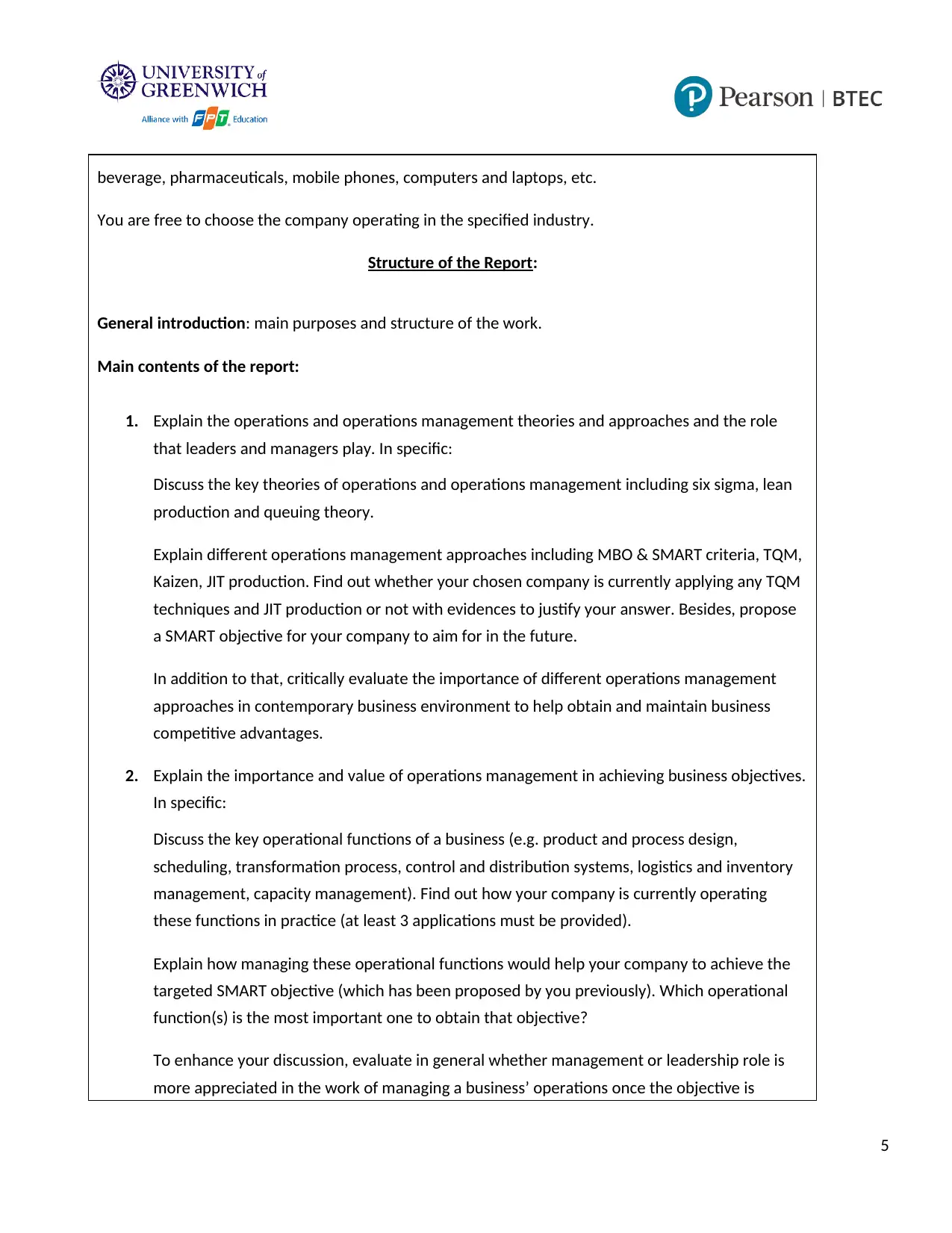
beverage, pharmaceuticals, mobile phones, computers and laptops, etc.
You are free to choose the company operating in the specified industry.
Structure of the Report:
General introduction: main purposes and structure of the work.
Main contents of the report:
1. Explain the operations and operations management theories and approaches and the role
that leaders and managers play. In specific:
Discuss the key theories of operations and operations management including six sigma, lean
production and queuing theory.
Explain different operations management approaches including MBO & SMART criteria, TQM,
Kaizen, JIT production. Find out whether your chosen company is currently applying any TQM
techniques and JIT production or not with evidences to justify your answer. Besides, propose
a SMART objective for your company to aim for in the future.
In addition to that, critically evaluate the importance of different operations management
approaches in contemporary business environment to help obtain and maintain business
competitive advantages.
2. Explain the importance and value of operations management in achieving business objectives.
In specific:
Discuss the key operational functions of a business (e.g. product and process design,
scheduling, transformation process, control and distribution systems, logistics and inventory
management, capacity management). Find out how your company is currently operating
these functions in practice (at least 3 applications must be provided).
Explain how managing these operational functions would help your company to achieve the
targeted SMART objective (which has been proposed by you previously). Which operational
function(s) is the most important one to obtain that objective?
To enhance your discussion, evaluate in general whether management or leadership role is
more appreciated in the work of managing a business’ operations once the objective is
5
You are free to choose the company operating in the specified industry.
Structure of the Report:
General introduction: main purposes and structure of the work.
Main contents of the report:
1. Explain the operations and operations management theories and approaches and the role
that leaders and managers play. In specific:
Discuss the key theories of operations and operations management including six sigma, lean
production and queuing theory.
Explain different operations management approaches including MBO & SMART criteria, TQM,
Kaizen, JIT production. Find out whether your chosen company is currently applying any TQM
techniques and JIT production or not with evidences to justify your answer. Besides, propose
a SMART objective for your company to aim for in the future.
In addition to that, critically evaluate the importance of different operations management
approaches in contemporary business environment to help obtain and maintain business
competitive advantages.
2. Explain the importance and value of operations management in achieving business objectives.
In specific:
Discuss the key operational functions of a business (e.g. product and process design,
scheduling, transformation process, control and distribution systems, logistics and inventory
management, capacity management). Find out how your company is currently operating
these functions in practice (at least 3 applications must be provided).
Explain how managing these operational functions would help your company to achieve the
targeted SMART objective (which has been proposed by you previously). Which operational
function(s) is the most important one to obtain that objective?
To enhance your discussion, evaluate in general whether management or leadership role is
more appreciated in the work of managing a business’ operations once the objective is
5
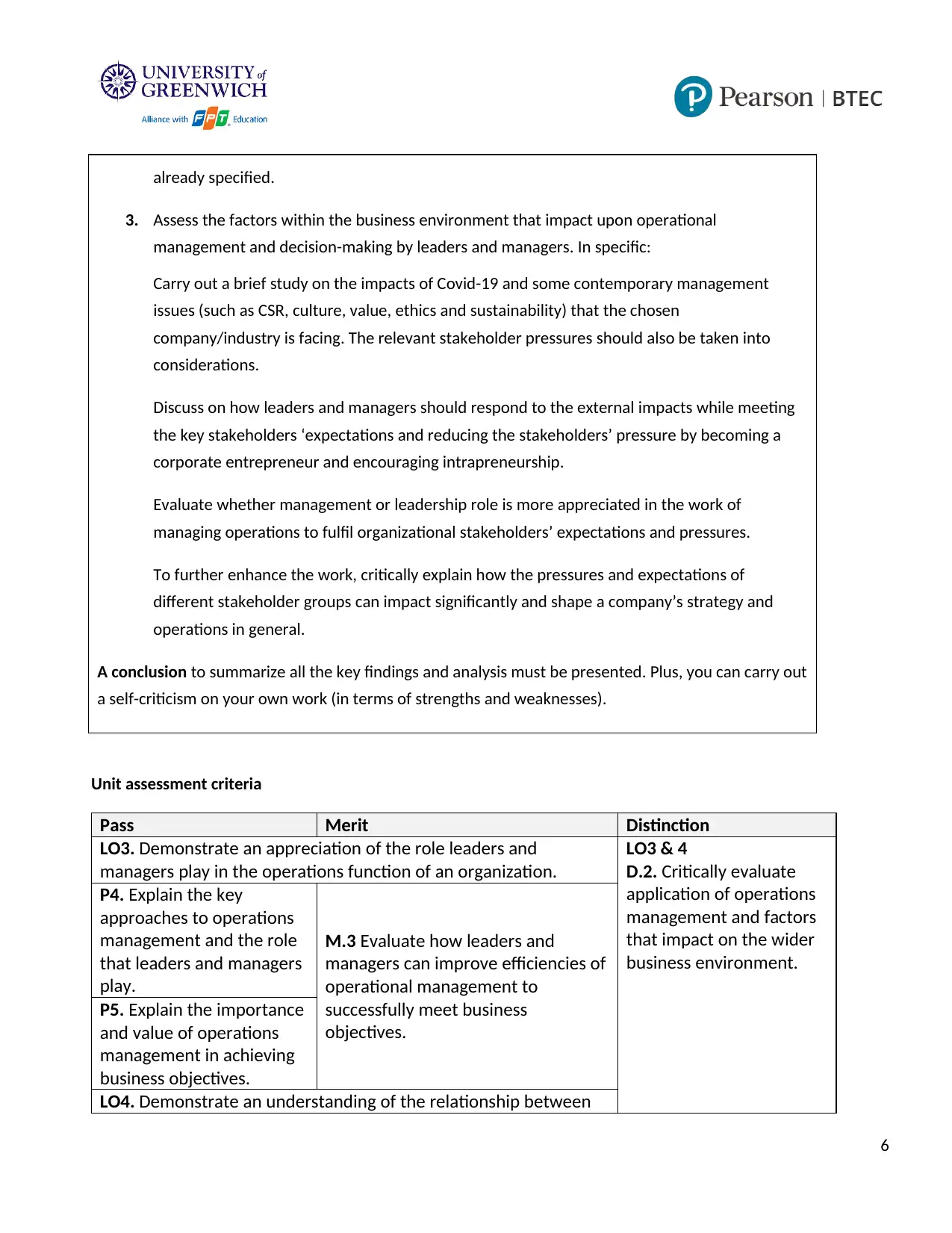
already specified.
3. Assess the factors within the business environment that impact upon operational
management and decision-making by leaders and managers. In specific:
Carry out a brief study on the impacts of Covid-19 and some contemporary management
issues (such as CSR, culture, value, ethics and sustainability) that the chosen
company/industry is facing. The relevant stakeholder pressures should also be taken into
considerations.
Discuss on how leaders and managers should respond to the external impacts while meeting
the key stakeholders ‘expectations and reducing the stakeholders’ pressure by becoming a
corporate entrepreneur and encouraging intrapreneurship.
Evaluate whether management or leadership role is more appreciated in the work of
managing operations to fulfil organizational stakeholders’ expectations and pressures.
To further enhance the work, critically explain how the pressures and expectations of
different stakeholder groups can impact significantly and shape a company’s strategy and
operations in general.
A conclusion to summarize all the key findings and analysis must be presented. Plus, you can carry out
a self-criticism on your own work (in terms of strengths and weaknesses).
Unit assessment criteria
Pass Merit Distinction
LO3. Demonstrate an appreciation of the role leaders and
managers play in the operations function of an organization.
LO3 & 4
D.2. Critically evaluate
application of operations
management and factors
that impact on the wider
business environment.
P4. Explain the key
approaches to operations
management and the role
that leaders and managers
play.
M.3 Evaluate how leaders and
managers can improve efficiencies of
operational management to
successfully meet business
objectives.
P5. Explain the importance
and value of operations
management in achieving
business objectives.
LO4. Demonstrate an understanding of the relationship between
6
3. Assess the factors within the business environment that impact upon operational
management and decision-making by leaders and managers. In specific:
Carry out a brief study on the impacts of Covid-19 and some contemporary management
issues (such as CSR, culture, value, ethics and sustainability) that the chosen
company/industry is facing. The relevant stakeholder pressures should also be taken into
considerations.
Discuss on how leaders and managers should respond to the external impacts while meeting
the key stakeholders ‘expectations and reducing the stakeholders’ pressure by becoming a
corporate entrepreneur and encouraging intrapreneurship.
Evaluate whether management or leadership role is more appreciated in the work of
managing operations to fulfil organizational stakeholders’ expectations and pressures.
To further enhance the work, critically explain how the pressures and expectations of
different stakeholder groups can impact significantly and shape a company’s strategy and
operations in general.
A conclusion to summarize all the key findings and analysis must be presented. Plus, you can carry out
a self-criticism on your own work (in terms of strengths and weaknesses).
Unit assessment criteria
Pass Merit Distinction
LO3. Demonstrate an appreciation of the role leaders and
managers play in the operations function of an organization.
LO3 & 4
D.2. Critically evaluate
application of operations
management and factors
that impact on the wider
business environment.
P4. Explain the key
approaches to operations
management and the role
that leaders and managers
play.
M.3 Evaluate how leaders and
managers can improve efficiencies of
operational management to
successfully meet business
objectives.
P5. Explain the importance
and value of operations
management in achieving
business objectives.
LO4. Demonstrate an understanding of the relationship between
6
⊘ This is a preview!⊘
Do you want full access?
Subscribe today to unlock all pages.

Trusted by 1+ million students worldwide
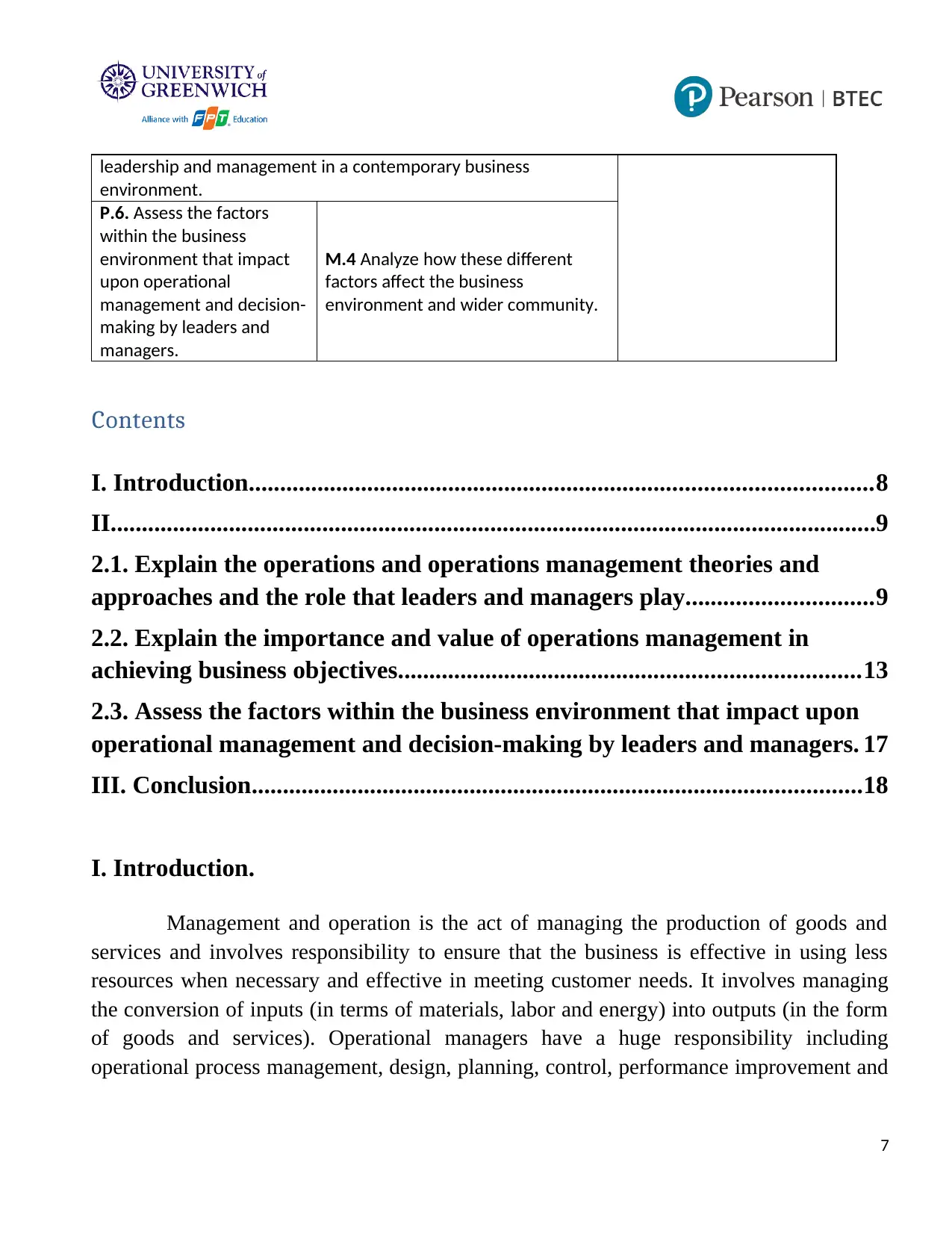
leadership and management in a contemporary business
environment.
P.6. Assess the factors
within the business
environment that impact
upon operational
management and decision-
making by leaders and
managers.
M.4 Analyze how these different
factors affect the business
environment and wider community.
Contents
I. Introduction....................................................................................................8
II...........................................................................................................................9
2.1. Explain the operations and operations management theories and
approaches and the role that leaders and managers play..............................9
2.2. Explain the importance and value of operations management in
achieving business objectives..........................................................................13
2.3. Assess the factors within the business environment that impact upon
operational management and decision-making by leaders and managers. 17
III. Conclusion..................................................................................................18
I. Introduction.
Management and operation is the act of managing the production of goods and
services and involves responsibility to ensure that the business is effective in using less
resources when necessary and effective in meeting customer needs. It involves managing
the conversion of inputs (in terms of materials, labor and energy) into outputs (in the form
of goods and services). Operational managers have a huge responsibility including
operational process management, design, planning, control, performance improvement and
7
environment.
P.6. Assess the factors
within the business
environment that impact
upon operational
management and decision-
making by leaders and
managers.
M.4 Analyze how these different
factors affect the business
environment and wider community.
Contents
I. Introduction....................................................................................................8
II...........................................................................................................................9
2.1. Explain the operations and operations management theories and
approaches and the role that leaders and managers play..............................9
2.2. Explain the importance and value of operations management in
achieving business objectives..........................................................................13
2.3. Assess the factors within the business environment that impact upon
operational management and decision-making by leaders and managers. 17
III. Conclusion..................................................................................................18
I. Introduction.
Management and operation is the act of managing the production of goods and
services and involves responsibility to ensure that the business is effective in using less
resources when necessary and effective in meeting customer needs. It involves managing
the conversion of inputs (in terms of materials, labor and energy) into outputs (in the form
of goods and services). Operational managers have a huge responsibility including
operational process management, design, planning, control, performance improvement and
7
Paraphrase This Document
Need a fresh take? Get an instant paraphrase of this document with our AI Paraphraser
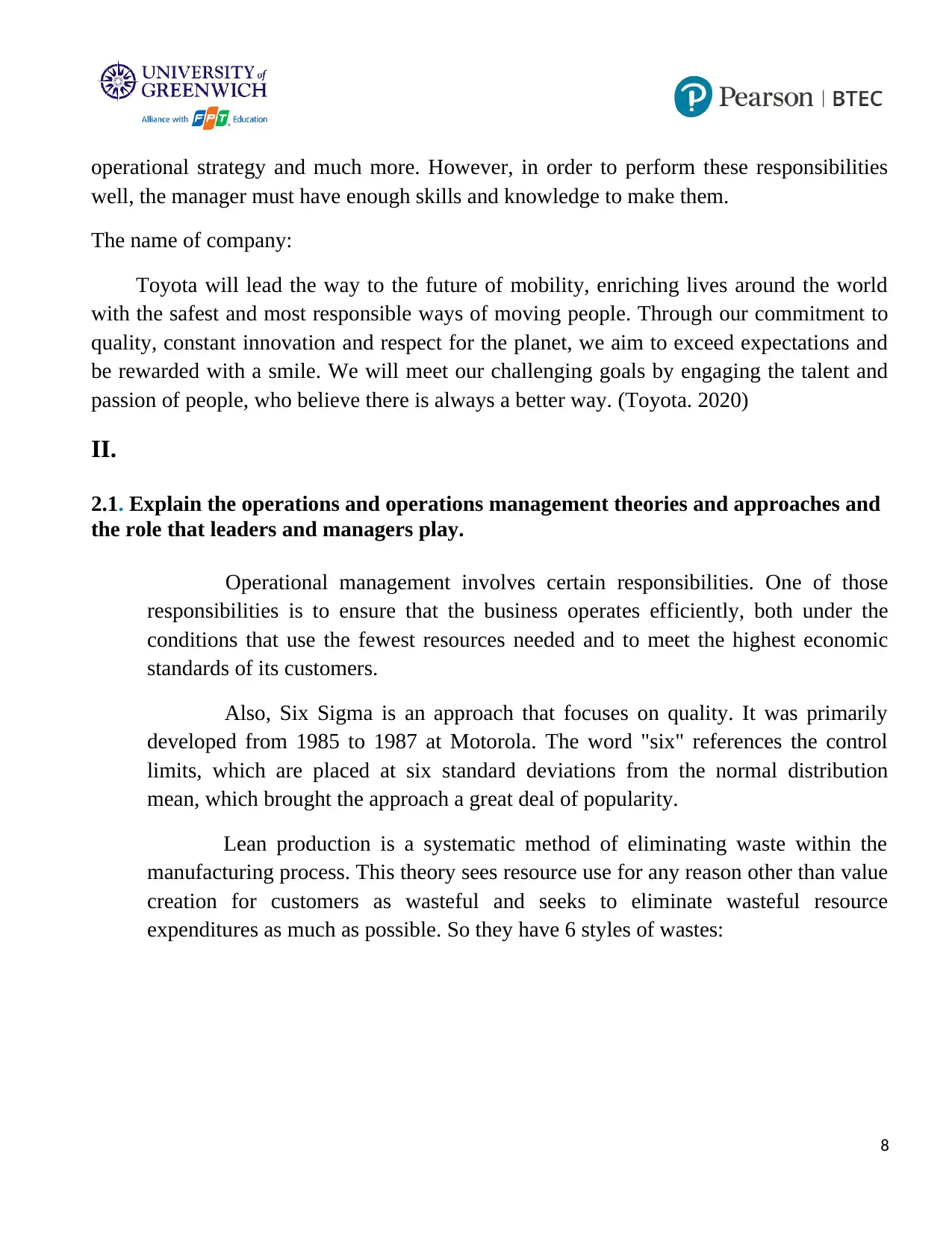
operational strategy and much more. However, in order to perform these responsibilities
well, the manager must have enough skills and knowledge to make them.
The name of company:
Toyota will lead the way to the future of mobility, enriching lives around the world
with the safest and most responsible ways of moving people. Through our commitment to
quality, constant innovation and respect for the planet, we aim to exceed expectations and
be rewarded with a smile. We will meet our challenging goals by engaging the talent and
passion of people, who believe there is always a better way. (Toyota. 2020)
II.
2.1. Explain the operations and operations management theories and approaches and
the role that leaders and managers play.
Operational management involves certain responsibilities. One of those
responsibilities is to ensure that the business operates efficiently, both under the
conditions that use the fewest resources needed and to meet the highest economic
standards of its customers.
Also, Six Sigma is an approach that focuses on quality. It was primarily
developed from 1985 to 1987 at Motorola. The word "six" references the control
limits, which are placed at six standard deviations from the normal distribution
mean, which brought the approach a great deal of popularity.
Lean production is a systematic method of eliminating waste within the
manufacturing process. This theory sees resource use for any reason other than value
creation for customers as wasteful and seeks to eliminate wasteful resource
expenditures as much as possible. So they have 6 styles of wastes:
8
well, the manager must have enough skills and knowledge to make them.
The name of company:
Toyota will lead the way to the future of mobility, enriching lives around the world
with the safest and most responsible ways of moving people. Through our commitment to
quality, constant innovation and respect for the planet, we aim to exceed expectations and
be rewarded with a smile. We will meet our challenging goals by engaging the talent and
passion of people, who believe there is always a better way. (Toyota. 2020)
II.
2.1. Explain the operations and operations management theories and approaches and
the role that leaders and managers play.
Operational management involves certain responsibilities. One of those
responsibilities is to ensure that the business operates efficiently, both under the
conditions that use the fewest resources needed and to meet the highest economic
standards of its customers.
Also, Six Sigma is an approach that focuses on quality. It was primarily
developed from 1985 to 1987 at Motorola. The word "six" references the control
limits, which are placed at six standard deviations from the normal distribution
mean, which brought the approach a great deal of popularity.
Lean production is a systematic method of eliminating waste within the
manufacturing process. This theory sees resource use for any reason other than value
creation for customers as wasteful and seeks to eliminate wasteful resource
expenditures as much as possible. So they have 6 styles of wastes:
8
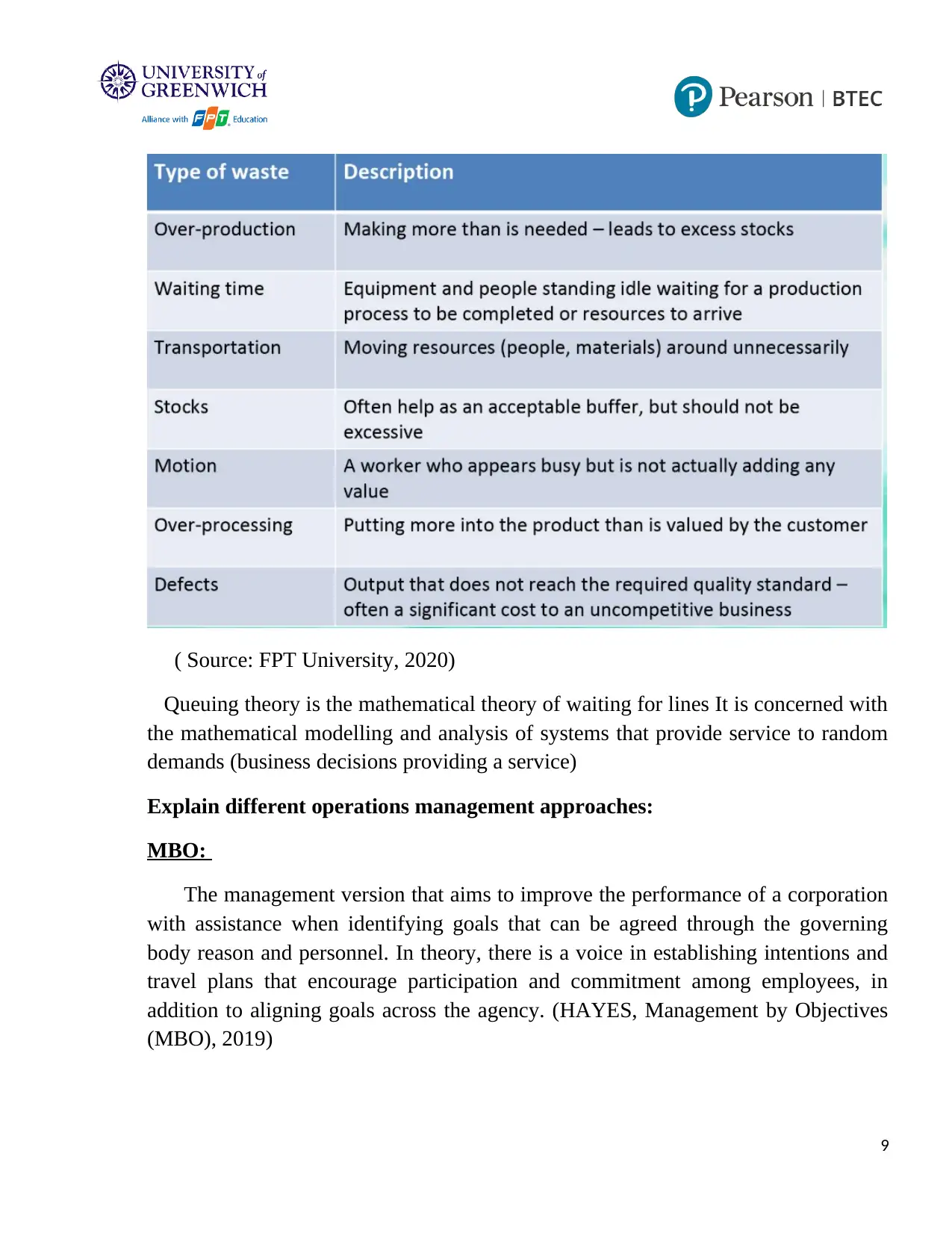
( Source: FPT University, 2020)
Queuing theory is the mathematical theory of waiting for lines It is concerned with
the mathematical modelling and analysis of systems that provide service to random
demands (business decisions providing a service)
Explain different operations management approaches:
MBO:
The management version that aims to improve the performance of a corporation
with assistance when identifying goals that can be agreed through the governing
body reason and personnel. In theory, there is a voice in establishing intentions and
travel plans that encourage participation and commitment among employees, in
addition to aligning goals across the agency. (HAYES, Management by Objectives
(MBO), 2019)
9
Queuing theory is the mathematical theory of waiting for lines It is concerned with
the mathematical modelling and analysis of systems that provide service to random
demands (business decisions providing a service)
Explain different operations management approaches:
MBO:
The management version that aims to improve the performance of a corporation
with assistance when identifying goals that can be agreed through the governing
body reason and personnel. In theory, there is a voice in establishing intentions and
travel plans that encourage participation and commitment among employees, in
addition to aligning goals across the agency. (HAYES, Management by Objectives
(MBO), 2019)
9
⊘ This is a preview!⊘
Do you want full access?
Subscribe today to unlock all pages.

Trusted by 1+ million students worldwide
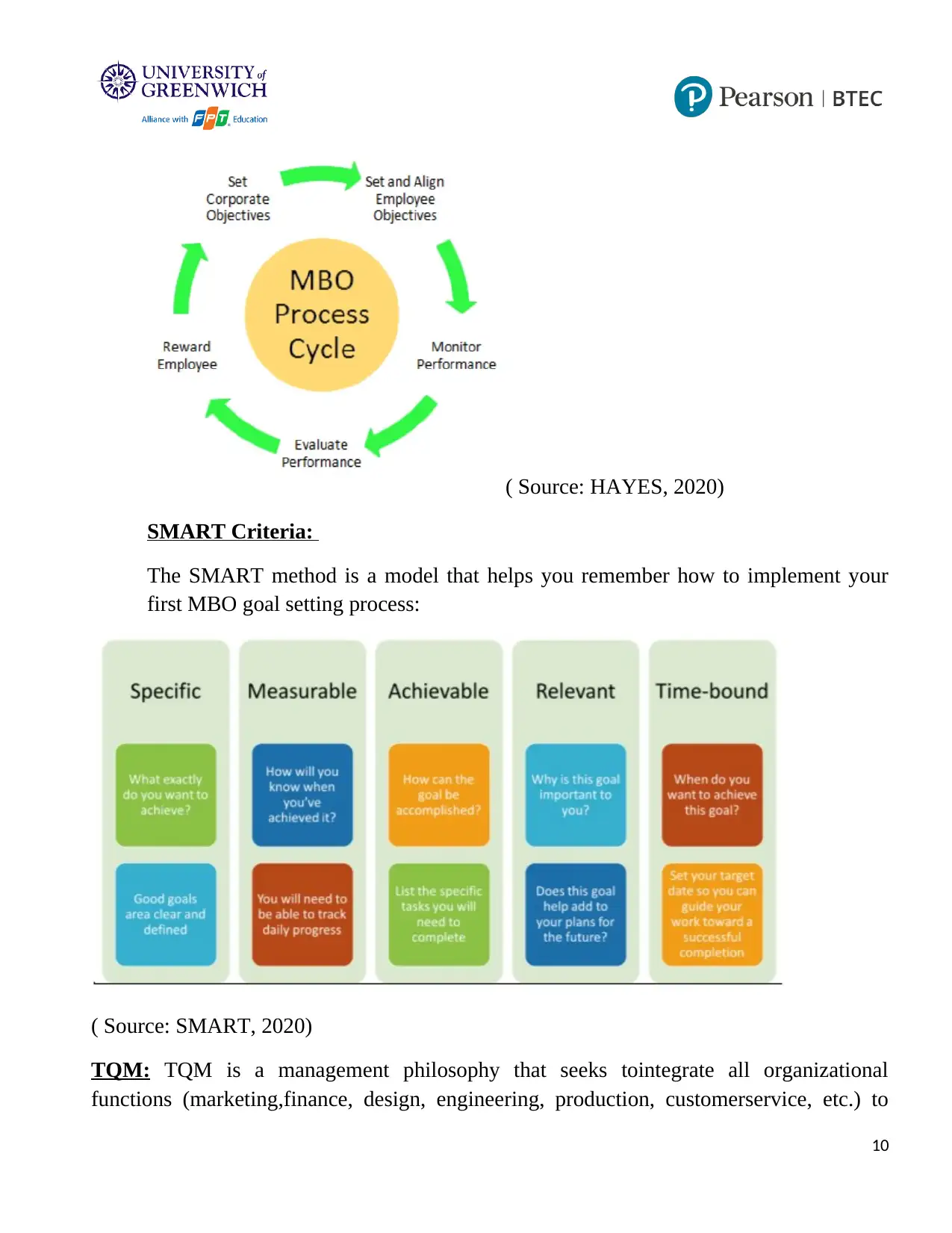
( Source: HAYES, 2020)
SMART Criteria:
The SMART method is a model that helps you remember how to implement your
first MBO goal setting process:
( Source: SMART, 2020)
TQM: TQM is a management philosophy that seeks tointegrate all organizational
functions (marketing,finance, design, engineering, production, customerservice, etc.) to
10
SMART Criteria:
The SMART method is a model that helps you remember how to implement your
first MBO goal setting process:
( Source: SMART, 2020)
TQM: TQM is a management philosophy that seeks tointegrate all organizational
functions (marketing,finance, design, engineering, production, customerservice, etc.) to
10
Paraphrase This Document
Need a fresh take? Get an instant paraphrase of this document with our AI Paraphraser
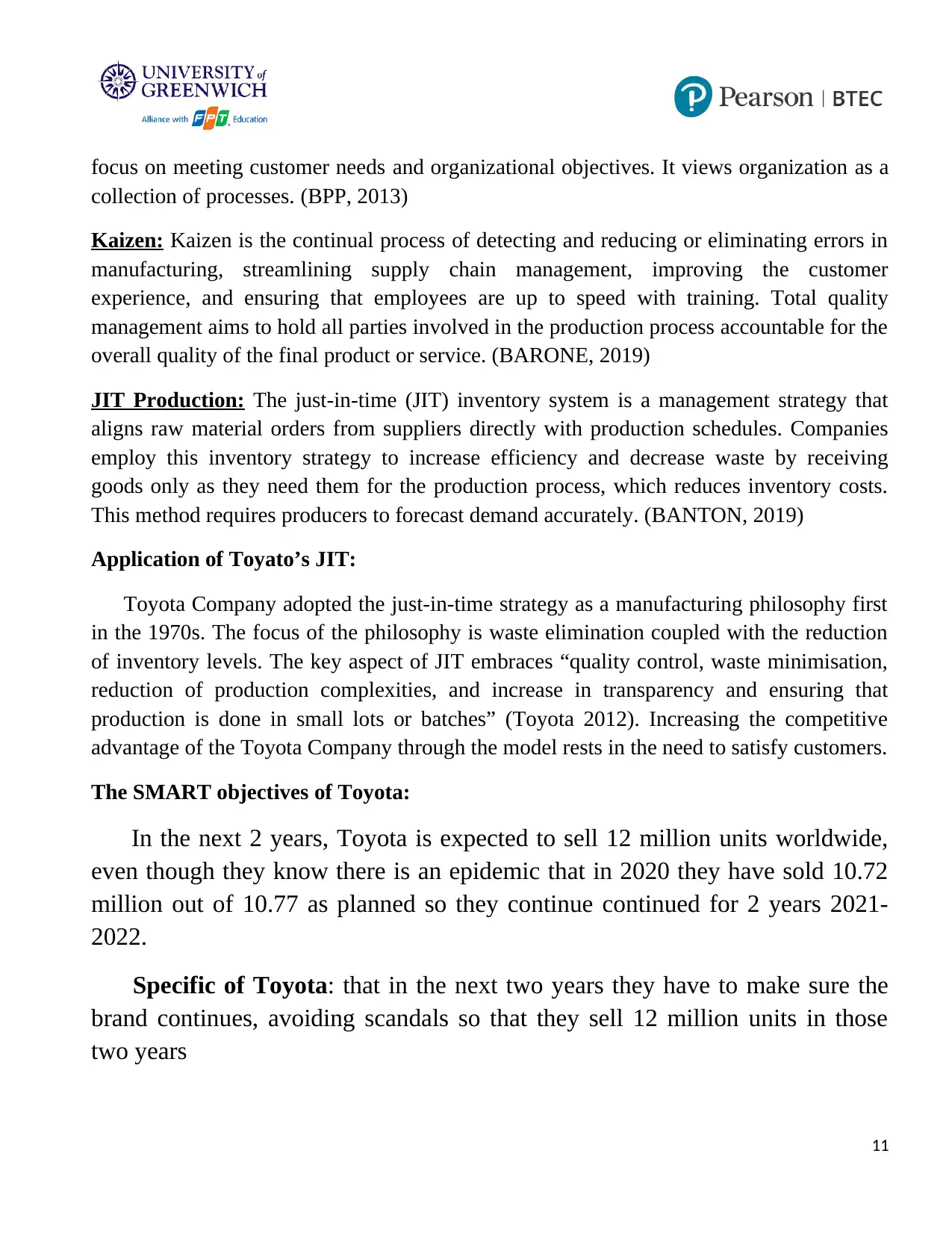
focus on meeting customer needs and organizational objectives. It views organization as a
collection of processes. (BPP, 2013)
Kaizen: Kaizen is the continual process of detecting and reducing or eliminating errors in
manufacturing, streamlining supply chain management, improving the customer
experience, and ensuring that employees are up to speed with training. Total quality
management aims to hold all parties involved in the production process accountable for the
overall quality of the final product or service. (BARONE, 2019)
JIT Production: The just-in-time (JIT) inventory system is a management strategy that
aligns raw material orders from suppliers directly with production schedules. Companies
employ this inventory strategy to increase efficiency and decrease waste by receiving
goods only as they need them for the production process, which reduces inventory costs.
This method requires producers to forecast demand accurately. (BANTON, 2019)
Application of Toyato’s JIT:
Toyota Company adopted the just-in-time strategy as a manufacturing philosophy first
in the 1970s. The focus of the philosophy is waste elimination coupled with the reduction
of inventory levels. The key aspect of JIT embraces “quality control, waste minimisation,
reduction of production complexities, and increase in transparency and ensuring that
production is done in small lots or batches” (Toyota 2012). Increasing the competitive
advantage of the Toyota Company through the model rests in the need to satisfy customers.
The SMART objectives of Toyota:
In the next 2 years, Toyota is expected to sell 12 million units worldwide,
even though they know there is an epidemic that in 2020 they have sold 10.72
million out of 10.77 as planned so they continue continued for 2 years 2021-
2022.
Specific of Toyota: that in the next two years they have to make sure the
brand continues, avoiding scandals so that they sell 12 million units in those
two years
11
collection of processes. (BPP, 2013)
Kaizen: Kaizen is the continual process of detecting and reducing or eliminating errors in
manufacturing, streamlining supply chain management, improving the customer
experience, and ensuring that employees are up to speed with training. Total quality
management aims to hold all parties involved in the production process accountable for the
overall quality of the final product or service. (BARONE, 2019)
JIT Production: The just-in-time (JIT) inventory system is a management strategy that
aligns raw material orders from suppliers directly with production schedules. Companies
employ this inventory strategy to increase efficiency and decrease waste by receiving
goods only as they need them for the production process, which reduces inventory costs.
This method requires producers to forecast demand accurately. (BANTON, 2019)
Application of Toyato’s JIT:
Toyota Company adopted the just-in-time strategy as a manufacturing philosophy first
in the 1970s. The focus of the philosophy is waste elimination coupled with the reduction
of inventory levels. The key aspect of JIT embraces “quality control, waste minimisation,
reduction of production complexities, and increase in transparency and ensuring that
production is done in small lots or batches” (Toyota 2012). Increasing the competitive
advantage of the Toyota Company through the model rests in the need to satisfy customers.
The SMART objectives of Toyota:
In the next 2 years, Toyota is expected to sell 12 million units worldwide,
even though they know there is an epidemic that in 2020 they have sold 10.72
million out of 10.77 as planned so they continue continued for 2 years 2021-
2022.
Specific of Toyota: that in the next two years they have to make sure the
brand continues, avoiding scandals so that they sell 12 million units in those
two years
11
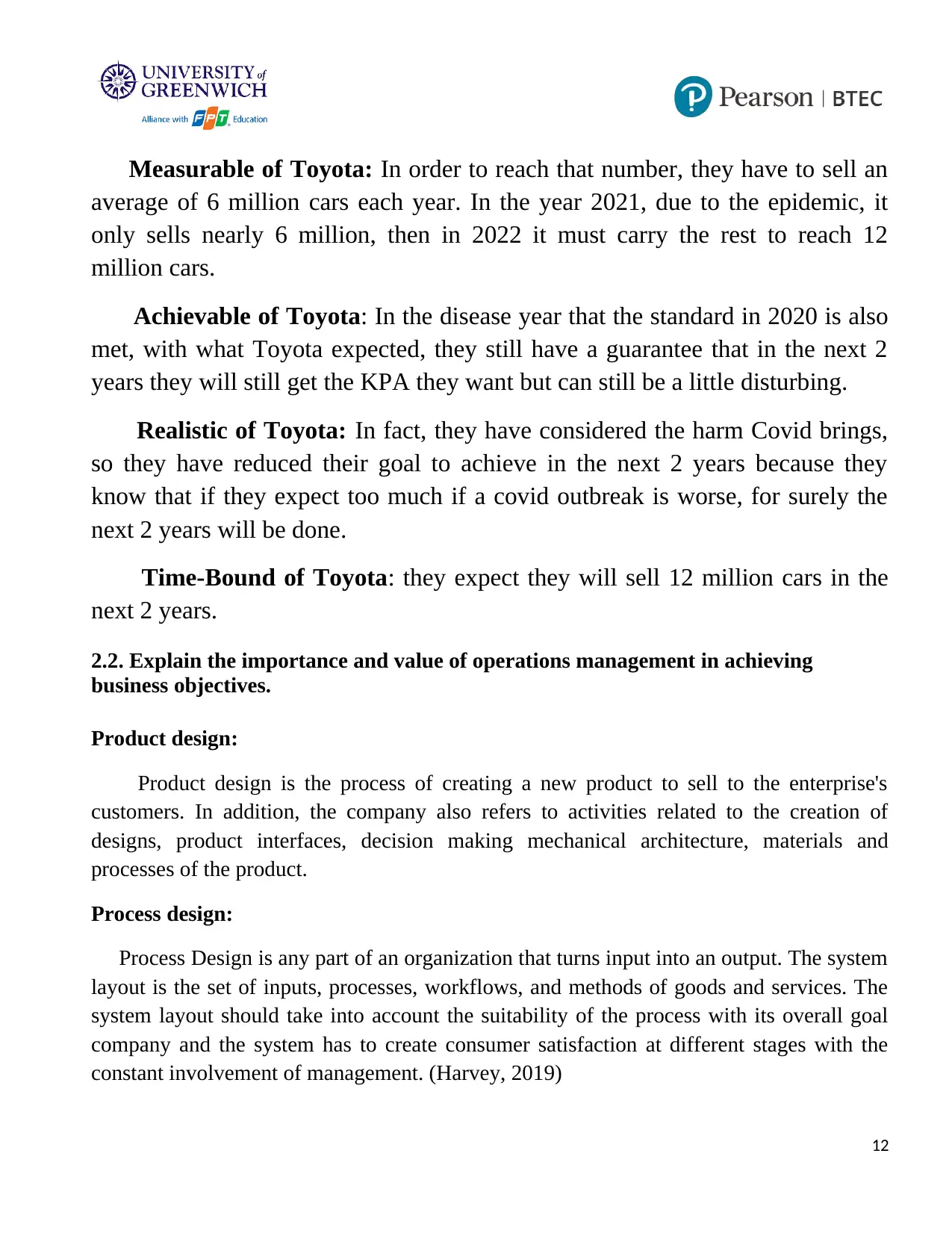
Measurable of Toyota: In order to reach that number, they have to sell an
average of 6 million cars each year. In the year 2021, due to the epidemic, it
only sells nearly 6 million, then in 2022 it must carry the rest to reach 12
million cars.
Achievable of Toyota: In the disease year that the standard in 2020 is also
met, with what Toyota expected, they still have a guarantee that in the next 2
years they will still get the KPA they want but can still be a little disturbing.
Realistic of Toyota: In fact, they have considered the harm Covid brings,
so they have reduced their goal to achieve in the next 2 years because they
know that if they expect too much if a covid outbreak is worse, for surely the
next 2 years will be done.
Time-Bound of Toyota: they expect they will sell 12 million cars in the
next 2 years.
2.2. Explain the importance and value of operations management in achieving
business objectives.
Product design:
Product design is the process of creating a new product to sell to the enterprise's
customers. In addition, the company also refers to activities related to the creation of
designs, product interfaces, decision making mechanical architecture, materials and
processes of the product.
Process design:
Process Design is any part of an organization that turns input into an output. The system
layout is the set of inputs, processes, workflows, and methods of goods and services. The
system layout should take into account the suitability of the process with its overall goal
company and the system has to create consumer satisfaction at different stages with the
constant involvement of management. (Harvey, 2019)
12
average of 6 million cars each year. In the year 2021, due to the epidemic, it
only sells nearly 6 million, then in 2022 it must carry the rest to reach 12
million cars.
Achievable of Toyota: In the disease year that the standard in 2020 is also
met, with what Toyota expected, they still have a guarantee that in the next 2
years they will still get the KPA they want but can still be a little disturbing.
Realistic of Toyota: In fact, they have considered the harm Covid brings,
so they have reduced their goal to achieve in the next 2 years because they
know that if they expect too much if a covid outbreak is worse, for surely the
next 2 years will be done.
Time-Bound of Toyota: they expect they will sell 12 million cars in the
next 2 years.
2.2. Explain the importance and value of operations management in achieving
business objectives.
Product design:
Product design is the process of creating a new product to sell to the enterprise's
customers. In addition, the company also refers to activities related to the creation of
designs, product interfaces, decision making mechanical architecture, materials and
processes of the product.
Process design:
Process Design is any part of an organization that turns input into an output. The system
layout is the set of inputs, processes, workflows, and methods of goods and services. The
system layout should take into account the suitability of the process with its overall goal
company and the system has to create consumer satisfaction at different stages with the
constant involvement of management. (Harvey, 2019)
12
⊘ This is a preview!⊘
Do you want full access?
Subscribe today to unlock all pages.

Trusted by 1+ million students worldwide
1 out of 19
Related Documents
Your All-in-One AI-Powered Toolkit for Academic Success.
+13062052269
info@desklib.com
Available 24*7 on WhatsApp / Email
![[object Object]](/_next/static/media/star-bottom.7253800d.svg)
Unlock your academic potential
Copyright © 2020–2025 A2Z Services. All Rights Reserved. Developed and managed by ZUCOL.





